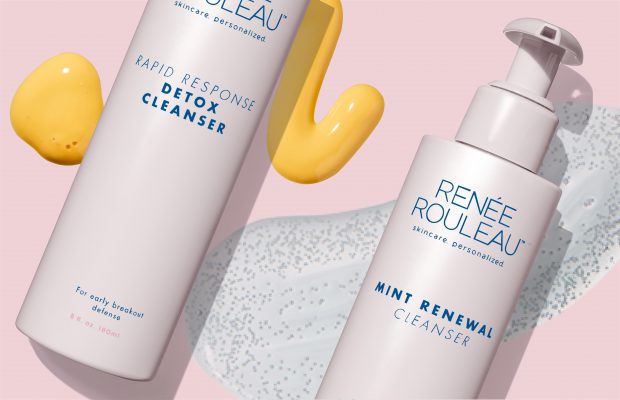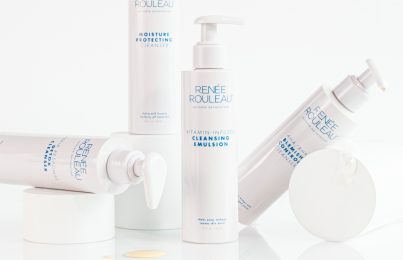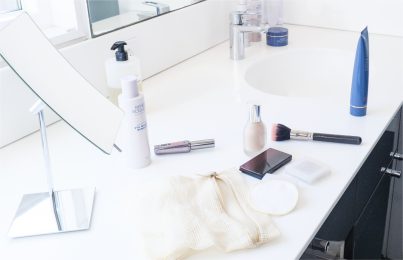Updated 08/31/21. Cleansers generally all have the same basic function—they clean dirt, debris, oil, bacteria, and makeup from the skin. Simple, right? Because of this, you might think you know everything about how to properly wash your face, when, in reality, there are certain mistakes I often see my clients make when it comes time to choose (and use) a cleanser. Keep scrolling to see my expert tips for getting the best cleansing experience possible.
- 1. DO Use a Cleanser Made Exclusively For Your Skin Type
- 2. DO Avoid Cleansers That Contain Fragrances—Especially If Your Skin Is Sensitive
- 3. DO Switch Cleansers Every Season, If Necessary
- 4. DO Wipe Your Skin After Cleansing
- 5. DO Limit the Use of a Sonic Cleansing Brush
- 6. DO Apply Your Next Product Within 60 Seconds of Cleansing
- 7. DON’T Use a Cleanser That Makes Your Skin Feel Tight
- 8. DON’T Use Bar Soap Cleansing Wipes
- 9. DON’T Use a Cleansing Oil or Cleansing Balm
1. DO Use a Cleanser Made Exclusively For Your Skin Type
It’s difficult for me to understand how some skincare companies say that their cleansers are “suitable for all skin types” when all skin is different and individuals have unique requirements when it comes to the products they use. Since a cleanser is a staple in both a morning and evening routine, it’s essential that you’re using one that’s formulated specifically for your goals and concerns. That’s why I developed products designed for nine specific skin types—far beyond the standard normal, oil, and dry. If you don’t know your skin type, take the skin type quiz to find out. You’ll also get personalized product recommendations at the end.
2. DO Avoid Cleansers That Contain Fragrances—Especially If Your Skin Is Sensitive
Individuals with sensitive skin can react negatively to fragrance, whether natural or synthetic. In fact, this is thought to be the top cause of allergic reactions for sensitive skin. So, before purchasing a cleanser, I recommend taking a look at the ingredient list. Avoid products that contain anything with the words, “parfum,” “perfume,” or “fragrance.” Information regarding fragrance is usually found towards the end of the ingredient list. (Learn more about understanding ingredient labels and percentages.)
3. DO Switch Cleansers Every Season, If Necessary
The climate in which you live directly affects your skin’s ability to retain moisture and balance oil production. If you live in a humid environment or have oily skin, use a foaming, gel cleanser. If you live in a dry environment, a lotion-based cleanser may be best. Reassess your cleanser (as well as all of your other products) every time the season changes for the best results.
4. DO Wipe Your Skin After Cleansing
This is particularly true when you’re washing your face at night with a cleansing lotion. It’s important to physically wipe over your skin with a facial sponge or baby washcloth to properly remove makeup, dirt, and oil. That way, you won’t find it on your cotton pad or toning cloth when you applying toner, later. Here’s a step-by-step guide on how to properly wash your face (many people get it wrong!).
5. DO Limit the Use of a Sonic Cleansing Brush
Sonic cleansing brushes are popular, and many of the brands that sell them suggest using them every time you wash your face. However, I think this is way too much for the skin. In fact, I only suggest using one no more than three times a week (if at all). The fact of the matter is that they exfoliate your skin every time you use one, and too much exfoliation can lead to things like dryness and irritation. Read more about this, here.
6. DO Apply Your Next Product Within 60 Seconds of Cleansing
After cleansing, you must immediately follow up with an alcohol-free toner, serum (optional), and moisturizer. I call this the Golden Minute Rule, as it prevents transepidermal water loss (TEWL) from occurring, thus helping to keep your skin plump and hydrated post-cleanse. If you leave your skin bare for more than one minute after cleansing, it can start to dehydrate and feel tight and uncomfortable.
7. DON’T Use a Cleanser That Makes Your Skin Feel Tight
When learning how to properly wash your face, it’s important to know that the type of cleanser you use makes a big difference in the state of your skin. Many foaming cleansers are formulated with ingredients like sodium lauryl sulfate, sodium laureth sulfate, and ammonium laureth sulfate. These ingredients are known as surfactants; they’re cleansing agents that cut oil from the skin. The problem with the specific ones listed is that they are simply too harsh. They can really strip water out of your skin.
Your cleanser is actually the most critical part of your skincare routine. Why? Because if you wash your face with a foaming cleanser or soap that is too drying, it pulls all the water out of the skin and creates dead, dry cell buildup. To remedy this, you have to quickly apply moisturizer to infuse the hydration that you just removed. It makes no sense, right? That’s why it’s important to choose either a cleansing lotion and/or a gel cleanser that does NOT contain these drying ingredients. Look for the words “sulfate-free” to guarantee a more gentle cleansing experience. See this collection of gentle, yet effective cleansers.
8. DON’T Use Bar Soap Cleansing Wipes
Washing your face with bar soap—no matter how expensive it is or how moisturizing it claims to be—is a no-no. The binders that hold a bar of soap together naturally have a high pH. This means they’ll always be too strong for the skin. When you cleanse with something too harsh, just liked sulfate-based cleansers, it can strip water from the skin. Again, this leaves it dehydrated with dry skin cell build-up. That’s why bar soaps are more suitable for the body, not the face. (However, I never use bar soap on my body either. I have a condition known as keratosis pilaris which causes little “chicken bumps” to appear on my skin. Bar soaps only make this condition worse. Here’s what I use instead.)
As for cleansing wipes, I believe they are not a smart choice because they don’t effectively clean the skin. Instead, they just smear dirt, bacteria, oil, and makeup across it. You see, a cleanser when used without the addition of water will break down and dissolve dirt in the oily portion of the soap molecule. However, it’s the actual rinsing action from water that removes it to truly cleanse the skin. Essentially, it’s like applying cleanser to your face and then not washing it off… Instead, I recommend using a gentle, sulfate-free cleansing gel or lightweight cleansing lotion to wash your face. Remember to wipe your skin with a facial sponge or baby washcloth afterward to ensure you’ve removed all debris.
9. DON’T Use a Cleansing Oil or Cleansing Balm
Cleansing balms and oils have large molecules that deposit a film onto the skin. This film prevents products that are applied afterward from getting through and making contact with the skin. For example, serums are generally composed of small molecules. You don’t want to put a small molecule on top of a large one, like that of oil. This prevents the smaller one from penetrating through, meaning your serum won’t be able to perform effectively. Read more about the double-cleansing method.
I prefer using cleansing lotions, like the Vitamin-Infused Cleansing Emulsion since they don’t deposit oil. Plus, they rinse off well. However, if you really want to use a cleansing oil or balm, be sure to use one that emulsifies, or rinses off the skin well, so there’s not a thick, oily residue left behind. Or, use a second gentle, foaming cleanser afterward and cut through any oil residue with a baby washcloth.
In summary, when learning how to properly wash your face, it comes down to the technique you use as well as the specific product you use. Choose your cleanser wisely! People often splurge most on moisturizers. However, people typically don’t give cleansers as much thought. They often choose something much more inexpensive from the drugstore, instead. Since cleansing is the first part of your routine, though, avoid using a low-quality cleanser. If you do, then your expensive serums and creams have to do even more work to control the potential damage caused by a dehydrating cleanser.
Next, learn how much of each skincare product you should actually be using!
Celebrity Esthetician & Skincare Expert
As an esthetician trained in cosmetic chemistry, Renée Rouleau has spent 35 years researching skin, educating her audience, and building an award-winning line of products. Her hands-on experience as an esthetician and trusted skin care expert has created a real-world solution — products that are formulated for nine different types of skin so your face will get exactly what it needs to look and feel its best. Trusted by celebrities, editors, bloggers, and skincare obsessives around the globe, her vast real-world knowledge and constant research are why Marie Claire calls her “the most passionate skin practitioner we know.”




Comments:
Should I Pat dry my face within the 60 seconds of cleansing and then applying toner/serum and moisturizer?
Posted By: Julio |
You will need to dry the face slightly after rinsing off a gel cleanser before moving to toner. If you are using a cream or clay cleanser you should remove the cleanser with a warm damp cloth and move right into toner, no rinsing needed.
Posted By: Renée Rouleau |